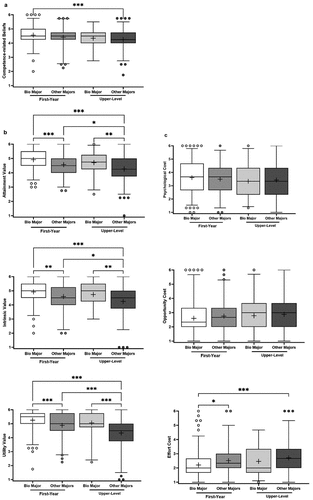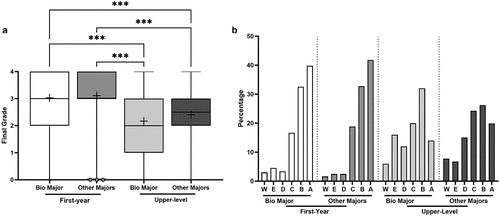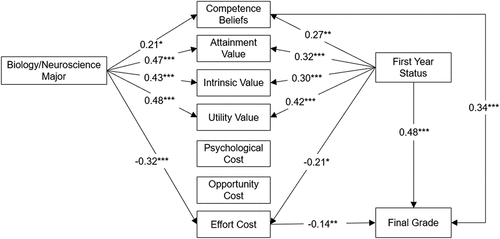Figures & data
Table 1. Student demographic information.
Table 2. Descriptive statistics and bivariate correlations.
Figure 1. Variation in motivation constructs by academic major and timing of enrollment. Students’ ratings on seven motivation constructs were compared by Kruskal-Wallis tests with post-hoc Dunn’s multiple comparisons tests for first-year and upper-level students separated by academic major (bio major = students with a biology/neuroscience major; other majors = students with other STEM majors). The center line is the median value (50th percentile), and the 25th to 75th percentiles of the dataset are represented by the box. The whiskers denote the 2.5th and 97.5th percentiles, and values beyond these upper and lower bounds are marked with dots. The mean value is indicated by the ‘+’.

Figure 2. Final course grades by major and timing of enrollment. (a) a box and whisker plot of final course grades was plotted on a 5-point scale (4 = A, 3 = B, 2 = C, 1 = D, 0 = E) for first-year and upper-level students (bio major = students with a biology/neuroscience major; other majors = students with other STEM majors). The centre line is the median value (50th percentile), and the 25th to 75th percentiles of the dataset are represented by the box. The whiskers denote the 2.5th and 97.5th percentiles, and values beyond these upper and lower bounds are marked with dots. The mean value is indicated by the ‘+’. Kruskal-Wallis tests with post-hoc Dunn’s multiple comparisons tests were used to compare means. *p < .05, **p < .01, ***p < .001 (b) the proportion of students with each grade type (W = withdrawal; E = failing grade) was graphed by first-year and upper-level status and academic major.

Figure 3. Path model illustrating significant relationships among variables. Reported coefficients are standardised. Correlations between motivation variables were included in the path model but are excluded from the figure for simplicity. *p < .05, **p < .01, ***p < .001.

Table 3. Results of the path model.
